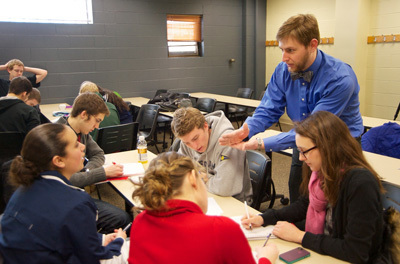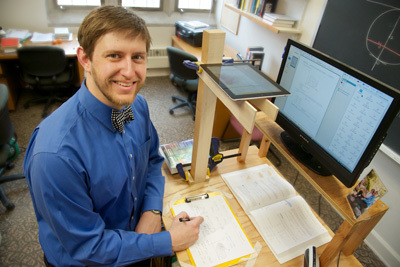

Simplifying concepts like partial derivatives and multiple integrals is a fun and rewarding job for Brian Shourd, a fourth year graduate student in the Department of Mathematics. This semester he is teaching Calculus III using a novel teaching method to help his students better understand and become more engaged in the material.
“My goal was to do more problem-solving in class. With limited class time, the only solution was to get rid of the lecture,” explained Shourd. “At first, I thought I could replace the lecture with reading assignments, but that didn’t seem very realistic since math textbooks can be difficult to comprehend. I decided to try creating video lectures for my students to watch as part of their homework assignments, so we could focus on problem solving during class.”
Class time is divided into three parts. Reading assessments are completed at the beginning of class to ensure that students understood the assigned video lectures and readings. The second part of class is dedicated to problem solving, and the end of class is reserved for group work.
“Watching the videos before class means that we are not seeing the material for the first time at 9:30 in the morning,” described freshman Bryan Ricketts. “Class is more of a refresher, and an opportunity to clarify important ideas. We have the chance to work through problems in class, allowing us to see if we have really learned the material. We wouldn't have this opportunity if the teacher was trying to get an entire lecture in during the limited class period.”
“Watching video lectures require more work prior to class since we have to take our own notes, but it holds us accountable. I like it a lot,” said Lucinda Krahl, a student in the class.

This method of teaching is known as a “flipped classroom.” “I really like being able to spend time in class on the things that are hard, like homework problems,” said Shourd. “Compared to my experience in more traditional classes, these students seem more engaged. They ask more questions and seem to understand concepts more clearly because they work on them in class.”
Compared to typical lectures, Shourd says there is less time involved in preparing and creating his video lectures. Using an iPad, he records himself writing problems and notes on paper while discussing the topics. Most lectures are filmed in one take, and there is almost no editing involved. Final video lectures are 20-30 minutes long and are posted on YouTube. In the future, Shourd hopes to find a way to incorporate interactive quizzes at the end of his videos.
“The focus was never about incorporating video into the course, but rather getting problems into the classroom,” said Shourd. “It is a lot more fun for me to teach this way.”
Feedback about the class has been extremely positive and Shourd is very well-liked and respected by his students.
“I think that one thing that makes this class work well is Brian's approachability and teaching style,” said Ricketts. “He encourages us to ask questions, and his demeanor makes it more exciting to come to class each day.”
“Brian is really good at explaining the information in more simple terms. I did really well on our first exam and felt really confident about it,” said Krahl. “He’s so happy and enthusiastic. He is the coolest teacher ever.”